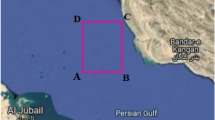Abstract
This study aims to address the three-dimensional path planning problem of autonomous underwater vehicle (AUV) in the environment of ocean current and seabed terrain obstacles, based on five biological swarm intelligent algorithm. Firstly, a three-dimensional seabed environment model and a Lamb vortex current environment model are established. Subsequently, a three-dimensional path planning mathematical model is established by considering the navigation distance, seabed terrain constraints and ocean current constraints. Furthermore, five biological swarm intelligent optimization algorithms are applied to solve the multi-objective nonlinear optimization problem. Finally, the experimental results show that the optimal path performance of the particle swarm optimization (PSO) algorithm is better than other algorithms. The planning speed of PSO algorithm is the fastest, and the robustness of WPA algorithm is the best. However, the planning time is the longest. The PSO algorithm is more suitable for three-dimensional path planning of AUV under the influence of seabed terrain obstacles and ocean currents.














Similar content being viewed by others
Data availability
Data available on request from the authors.
References
Yang Y, Xiao Y, Li T (2021) A survey of autonomous underwater vehicle formation: performance, formation control, and communication capability. IEEE Commun Surv Tutor 23(2):815–841
Gallimore E, Terrill E, Pietruszka A et al (2020) Magnetic survey and autonomous target reacquisition with a scalar magnetometer on a small AUV. J. Field Robot 37(7):1246–1266
Khan MTR, Jembre YZ, Ahmed SH et al (2020) Data freshness based AUV path planning for UWSN in the internet of underwater things. In: IEEE global communications conference
Chen SA, Chen YG, Zhu JY et al (2020) Path-planning analysis of AUV-aided mobile data collection in UWA cooperative sensor networks. In: 2020 IEEE international conference on signal processing, communications and computing
Yan Z, Zhang J, Tang J (2021) Path planning for autonomous underwater vehicle based on an enhanced water wave optimization algorithm. Math Comput Simul 181:192–241
Teng Ma, Ye Li, Yuxin Z et al (2020) An AUV localization and path planning algorithm for terrain-aided navigation. ISA Trans 103:215–227
Yao XL, Wang F, Wang JF et al (2020) Time-optimal path planning for autonomous underwater vehicles with uncertain ocean currents. Control Theory Appl 37(6):1302–1310
Zheng Z, Lian L, Karl S et al (2015) A survey on path planning for persistent autonomy of autonomous underwater vehicles. Ocean Eng 110(Part A):303–313
Chinmay SK, Pierre FJ et al (2020) Three-dimensional time-optimal path planning in the ocean. Ocean Model 152:101644
Wei S, Wang L, Wang B et al (2017) Improvement of A* algorithm and its application in AGV path planning. Process Autom Instrum 38(11):51–54
Sheng RAO, Lei CHU, Shan WANG (2012) Research of path planning of long-range underwater weapon based on D* algorithm direction pointer. Ship Electron Eng 32(11):31–32
Cheng C, Sha Q, He B, Li G (2021) Path planning and obstacle avoidance for AUV: a review. Ocean Eng 235:109355
Sheng L, Yu P, Zhao L et al (2021) Comparative study on AUV route planning algorithm considering influence of ocean current. J Naval Univ Eng 4(33):101–106
Huynh VT, Dunbabin M, Smith RN (2014) Convergence guaranteed time-varying RRT path planning for profiling floats in 4-dimensional flow. In: Proceedings of the Australian conference on robotics and automation
Sheng L, Su N, Luo R et al (2021) A novel algorithm for autonomous real-time route planning of AUV based on sub-target and level set method. Trans Beijing Inst Technol 41(2):158–168
Lolla T, Lermusiaux PFJ, Ueckermann MP, Haley PJ (2014) Time-optimal path planning in dynamic flows using level set equations: theory and schemes. Ocean Dyn 64(10):1373–1397
Feng W, Zhang JY, Wang Z et al (2017) A time-optimal path planning method based on quantum-behaved particle swarm optimization in ocean environment. J Nav Univ Eng 29(6):72–77
Qunhong T, Tao W, Yunxia W et al (2022) A two-level optimization algorithm for path planning of bionic robotic fish in the three-dimensional environment with ocean currents and moving obstacles. Ocean Eng 266(3):1–17
Tian Q, Wang T, Wang Y et al (2022) Robust optimization design for path planning of bionic robotic fish in the presence of ocean currents. J Mar Sci Eng 10(8):1109
Zhuang Y, Sharma S, Subudhi B et al (2016) Efficient collision-free path planning for autonomous underwater vehicles in dynamic environments with a hybrid optimization algorithm. Ocean Eng 127:190–199
Qi Z, Shao Z, Ping YS et al (2010) An improved heuristic algorithm of UAV path planning in 3D environment. In: Proceedings of 2nd intelligent human-machine systems and cybernetics. IEEE, Piscataway, pp 258–261
Garau B, Alvarez A, Oliver G (2006) AUV navigation through turbulent ocean environments supported by onboard H-ADCP. In: Proceedings of the 2006 IEEE international conference on robotics and automation Orlando, Florida, pp 3556–3661
Li X, Zhu D, Xu K (2016) Task assignment for a multi-AUV system under kinematic constraint. J Harbin Eng Univ 37(12):1638–1644
Xiao YJ, Ding MY, Peng JX (2018) Study on B-spline curve fitting method based on iterative nearest point. J Image Graph 5(7):585–588
Wu HS, Zhang FM, Wu LS (2013) A new swarm intelligence algorithm—Wolf pack algorithm. Syst Eng Electron 35(11):2430–2438
Li YN, Huang HB et al (2022) Energy-optimal three-dimensional path planning for AUV under changing ocean current environment. Syst Eng Electron 43(12):3667–3674
Zhou HX (2017) Research on path planning of unmanned underwater vehicle for long-duration missions based on energy consumption optimization in complex ocean environment. Harbin Engineering University, Harbin
Acknowledgements
The authors would like to thank the editors and the anonymous reviewers for their valuable comments and constructive suggestions. This work was supported by National Natural Science Foundation of China (62073054).
Author information
Authors and Affiliations
Corresponding author
Additional information
Publisher's Note
Springer Nature remains neutral with regard to jurisdictional claims in published maps and institutional affiliations.
About this article
Cite this article
Li, X., Yu, S. Comparison of biological swarm intelligence algorithms for AUVs for three-dimensional path planning in ocean currents’ conditions. J Mar Sci Technol 28, 832–843 (2023). https://doi.org/10.1007/s00773-023-00960-7
Received:
Accepted:
Published:
Issue Date:
DOI: https://doi.org/10.1007/s00773-023-00960-7




